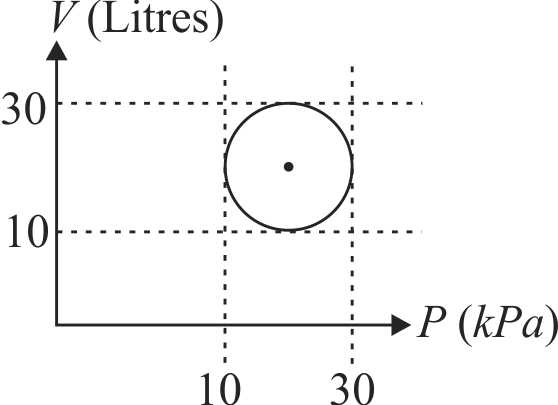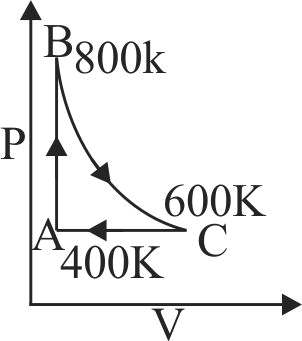371264
An ideal gas after going through a series of four thermodynamic states in order, reaches the initial state against (cyclic process). The amounts of heat and work involved in these states are
\({Q_1} = 6000\;J,{Q_2} = - 5500\;J\)
\({Q_3} = - 3000\,J,{Q_2} = 3500\,J\)
\({W_1} = 2500\,J,{W_2} = - 1000\,J\)
\({W_3} = - 1200\,J,{W_4} = x\,J\)
The ratio of net work done by the gas to the total heat absorbed by the gas is \(\eta\). The value of \(x\) and \(\eta\) are nearly
371264
An ideal gas after going through a series of four thermodynamic states in order, reaches the initial state against (cyclic process). The amounts of heat and work involved in these states are
\({Q_1} = 6000\;J,{Q_2} = - 5500\;J\)
\({Q_3} = - 3000\,J,{Q_2} = 3500\,J\)
\({W_1} = 2500\,J,{W_2} = - 1000\,J\)
\({W_3} = - 1200\,J,{W_4} = x\,J\)
The ratio of net work done by the gas to the total heat absorbed by the gas is \(\eta\). The value of \(x\) and \(\eta\) are nearly
371264
An ideal gas after going through a series of four thermodynamic states in order, reaches the initial state against (cyclic process). The amounts of heat and work involved in these states are
\({Q_1} = 6000\;J,{Q_2} = - 5500\;J\)
\({Q_3} = - 3000\,J,{Q_2} = 3500\,J\)
\({W_1} = 2500\,J,{W_2} = - 1000\,J\)
\({W_3} = - 1200\,J,{W_4} = x\,J\)
The ratio of net work done by the gas to the total heat absorbed by the gas is \(\eta\). The value of \(x\) and \(\eta\) are nearly
371264
An ideal gas after going through a series of four thermodynamic states in order, reaches the initial state against (cyclic process). The amounts of heat and work involved in these states are
\({Q_1} = 6000\;J,{Q_2} = - 5500\;J\)
\({Q_3} = - 3000\,J,{Q_2} = 3500\,J\)
\({W_1} = 2500\,J,{W_2} = - 1000\,J\)
\({W_3} = - 1200\,J,{W_4} = x\,J\)
The ratio of net work done by the gas to the total heat absorbed by the gas is \(\eta\). The value of \(x\) and \(\eta\) are nearly


